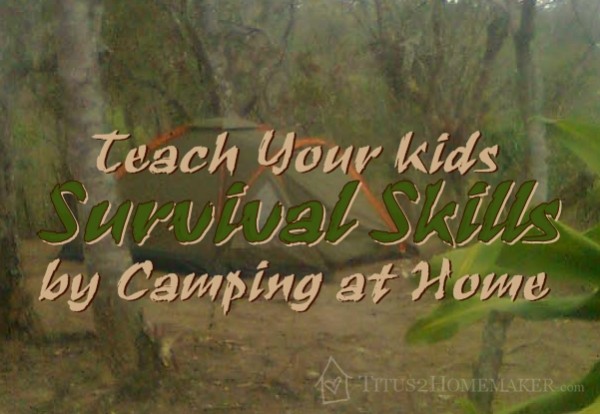by Lee Flynn

Survival skills are one of the most important things that children should learn. Sadly, other activities, such as piano lessons or soccer practice, leave little time to teach your children about surviving in case of a disaster. One way to get some fun teaching time in is to go camping in your backyard.
Setting Up Camp
If something happens to your home in a disaster, your family may end up needing a tent for more than just a weekend of fun. You may not even have a tent in some cases, so kids should eventually learn about not being completely dependent on camping gear, but learning how to pitch a tent is a great first step. They may need the directions and a little bit of help at first, but they should do better each time you take a backyard camping trip.
Food Storage
If you’re concerned about your children’s survival skills, chances are that you have stored food for emergency situations. Many families try to have enough food to last a certain number of months or even a year by purchasing shelf-stable products. One of the first things children should learn is how to prepare this type of cuisine. Having a lot of food that is ready-to-eat and doesn’t require water or heat is a good idea. On the other hand, if you have water and a way to cook food, it will be tastier, plus it will be easier to balance your diet.
Heating Up
If you have a portable cooking device, make sure all of your kids that are old enough learn how to use it safely. Even young ones can practice with heavy supervision. Learning how to use matches or a lighter properly to start a fire is one of the most important survival skills, and it can be used for both warmth and preparing food. If you’re feeling adventurous, you can even try to teach your children how to make a fire without matches. Teach them about clearing the area of grass or other flammable materials, feeding the fire once it’s started, and putting it out safely and completely.
Cooking the Food
Some foods are ready-to-eat after you take it out of the package, but other foods need to be cooked. Boiling is one of the easiest ways to do this. Show your kids that even though steam doesn’t look too dangerous, it’s actually hotter than the boiling water. Also teach them to conserve water and heat by using as little water as necessary and only cooking food until it reaches boiling point – the food isn’t going to get any hotter after that, and any harmful pathogens will have already been destroyed.
Cooking From Scratch
Kids are used to having everything put together: frozen pizza, ravioli from a can, etc… Some emergency foods are like this, but some aren’t. Just in case the packaged food runs out, you can teach your kids how to make things from scratch so they know how to use everything. Teach them how to grind wheat berries to make flour. Teach them how to use that flour to stir into boiling water to make gravy. The more things they know how to make, the better off they will be.
Most of the time, food that comes from storage isn’t hard to make – emergency food is made to need as little preparation as possible. Learning things like starting a fire, boiling water, and conserving energy are what kids need to know to be able to stay fed and survive.
Leave a Reply